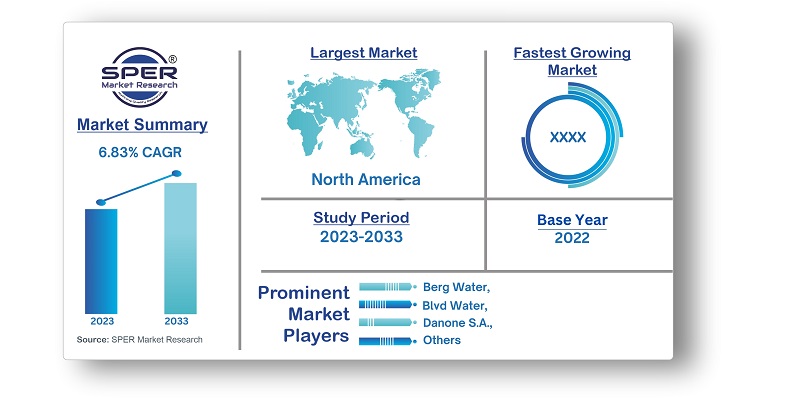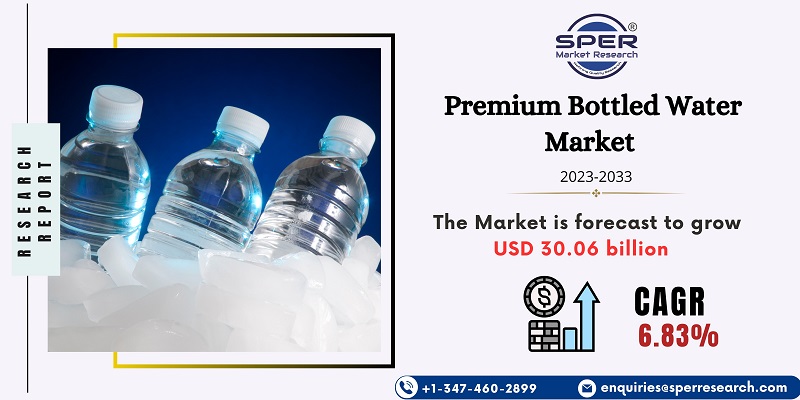
Premium Bottled Water Market Growth, Size, Trends, Revenue, Share, Scope and Future Outlook
Premium Bottled Water Market Size- By Product, By Distribution Channel- Regional Outlook, Competitive Strategies and Segment Forecast to 2033
| Published: Nov-2023 | Report ID: FMCG23137 | Pages: 1 - 234 | Formats*: |
| Category : Consumer & Retail | |||
- Lofoten Arctic Water introduced a series of metal bottles created by the Ball Corporation, a well-known global maker of aluminum cans, in January 2021. These aluminum bottles are designed to be eternally recyclable, coinciding with consumer preferences for environmentally friendly packaging alternatives.
- The world's first sustainable bottled drinking water brand will be available to Singapore's most prominent hotels thanks to a partnership between Accor and SOURCE Global, PBC.


| Report Metric | Details |
| Market size available for years | 2019-2033 |
| Base year considered | 2022 |
| Forecast period | 2023-2033 |
| Segments covered | By Product, By Distribution Channel |
| Regions covered | North America, Asia-Pacific, Latin America, Middle East & Africa and Europe |
| Companies Covered | Bling H2O, Blvd Water, Danone S.A., Gerolsteiner Brunnen GmbH & Co. KG, Lofoten Arctic Water AS, MINUS 181 GmbH, NEVAS GmbH, Roiwater, Uisge Source Inc. and Veen, Alpine Glacier Water Inc., Berg Water, Beverly Hills Drink Company. |
- Health-Conscious Consumers
- Affluent Consumers
- Gourmet and Fine Dining Consumers
- Fitness Enthusiasts
- Environmental Conscious Consumers
- Corporate and Events
| By Product: |
|
| By Distribution Channel: |
|
| By Region: |
|
- Global Premium Bottled Water Market Size (FY’2023-FY’2033)
- Overview of Global Premium Bottled Water Market
- Segmentation of Global Premium Bottled Water Market By Product (Spring Water, Sparkling Water, Mineral Water, Others)
- Segmentation of Global Premium Bottled Water Market By Distribution Channel (Supermarkets and Hypermarkets, Specialty Stores, Online Stores, Others)
- Statistical Snap of Global Premium Bottled Water Market
- Expansion Analysis of Global Premium Bottled Water Market
- Problems and Obstacles in Global Premium Bottled Water Market
- Competitive Landscape in the Global Premium Bottled Water Market
- Impact of COVID-19 and Demonetization on Global Premium Bottled Water Market
- Details on Current Investment in Global Premium Bottled Water Market
- Competitive Analysis of Global Premium Bottled Water Market
- Prominent Players in the Global Premium Bottled Water Market
- SWOT Analysis of Global Premium Bottled Water Market
- Global Premium Bottled Water Market Future Outlook and Projections (FY’2023-FY’2033)
- Recommendations from Analyst
1.1. Scope of the report1.2. Market segment analysis
2.1. Research data source
2.1.1. Secondary Data2.1.2. Primary Data2.1.3. SPER’s internal database2.1.4. Premium insight from KOL’s
2.2. Market size estimation
2.2.1. Top-down and Bottom-up approach
2.3. Data triangulation
4.1. Driver, Restraint, Opportunity and Challenges analysis4.1.1. Drivers4.1.2. Restraints4.1.3. Opportunities4.1.4. Challenges
4.2. COVID-19 Impacts of the Global Premium Bottled Water Market
5.1. SWOT Analysis
5.1.1. Strengths5.1.2. Weaknesses5.1.3. Opportunities5.1.4. Threats
5.2. PESTEL Analysis
5.2.1. Political Landscape5.2.2. Economic Landscape5.2.3. Social Landscape5.2.4. Technological Landscape5.2.5. Environmental Landscape5.2.6. Legal Landscape
5.3. PORTER’s Five Forces
5.3.1. Bargaining power of suppliers5.3.2. Bargaining power of buyers5.3.3. Threat of Substitute5.3.4. Threat of new entrant5.3.5. Competitive rivalry
5.4. Heat Map Analysis
6.1. Global Premium Bottled Water Market Manufacturing Base Distribution, Sales Area, Product Type6.2. Mergers & Acquisitions, Partnerships, Product Launch, and Collaboration in Global Premium Bottled Water Market
7.1. Global Premium Bottled Water Market Value Share and Forecast, By Product, 2023-20337.2. Spring Water7.3. Sparkling Water7.4. Mineral Water7.5. Others
8.1. Global Premium Bottled Water Market Value Share and Forecast, By Distribution Channel, 2023-20338.2. Supermarkets and Hypermarkets8.3. Specialty Stores8.4. Online Stores8.5. Others
9.1. Global Premium Bottled Water Market Size and Market Share
10.1. Global Premium Bottled Water Market Size and Market Share By Product (2019-2026)
10.2. Global Premium Bottled Water Market Size and Market Share By Product (2027-2033)
11.1. Global Premium Bottled Water Market Size and Market Share By Distribution Channel (2019-2026)11.2. Global Premium Bottled Water Market Size and Market Share By Distribution Channel (2027-2033)
12.1. Global Premium Bottled Water Market Size and Market Share By Region (2019-2026)12.2. Global Premium Bottled Water Market Size and Market Share By Region (2027-2033)
12.3. Asia-Pacific
12.3.1. Australia12.3.2. China12.3.3. India12.3.4. Japan12.3.5. South Korea12.3.6. Rest of Asia-Pacific
12.4. Europe
12.4.1. France12.4.2. Germany12.4.3. Italy12.4.4. Spain12.4.5. United Kingdom12.4.6. Rest of Europe
12.5. Middle East and Africa
12.5.1. Kingdom of Saudi Arabia12.5.2. United Arab Emirates12.5.3. Rest of Middle East & Africa
12.6. North America
12.6.1. Canada12.6.2. Mexico12.6.3. United States
12.7. Latin America
12.7.1. Argentina12.7.2. Brazil12.7.3. Rest of Latin America
13.1. Alpine Glacier Water Inc.
13.1.1. Company details13.1.2. Financial outlook13.1.3. Product summary13.1.4. Recent developments
13.2. Berg Water
13.2.1. Company details13.2.2. Financial outlook13.2.3. Product summary13.2.4. Recent developments
13.3. Beverly Hills Drink Company
13.3.1. Company details13.3.2. Financial outlook13.3.3. Product summary13.3.4. Recent developments
13.4. Bling H2O
13.4.1. Company details
13.4.2. Financial outlook13.4.3. Product summary13.4.4. Recent developments
13.5. Blvd Water
13.5.1. Company details13.5.2. Financial outlook13.5.3. Product summary13.5.4. Recent developments
13.6. Danone S.A.
13.6.1. Company details13.6.2. Financial outlook13.6.3. Product summary13.6.4. Recent developments
13.7. Gerolsteiner Brunnen GmbH & Co. KG
13.7.1. Company details13.7.2. Financial outlook13.7.3. Product summary13.7.4. Recent developments
13.8. Lofoten Arctic Water AS
13.8.1. Company details13.8.2. Financial outlook13.8.3. Product summary13.8.4. Recent developments
13.9. MINUS 181 GmbH
13.9.1. Company details13.9.2. Financial outlook13.9.3. Product summary13.9.4. Recent developments
13.10. NEVAS GmbH
13.10.1. Company details13.10.2. Financial outlook13.10.3. Product summary13.10.4. Recent developments
13.11. Roiwater
13.11.1. Company details13.11.2. Financial outlook13.11.3. Product summary13.11.4. Recent developments
13.12. Uisge Source Inc
13.12.1. Company details13.12.2. Financial outlook13.12.3. Product summary13.12.4. Recent developments
SPER Market Research’s methodology uses great emphasis on primary research to ensure that the market intelligence insights are up to date, reliable and accurate. Primary interviews are done with players involved in each phase of a supply chain to analyze the market forecasting. The secondary research method is used to help you fully understand how the future markets and the spending patterns look likes.
The report is based on in-depth qualitative and quantitative analysis of the Product Market. The quantitative analysis involves the application of various projection and sampling techniques. The qualitative analysis involves primary interviews, surveys, and vendor briefings. The data gathered as a result of these processes are validated through experts opinion. Our research methodology entails an ideal mixture of primary and secondary initiatives.



Frequently Asked Questions About This Report
PLACE AN ORDER
Year End Discount
Sample Report
Pre-Purchase Inquiry
NEED CUSTOMIZATION?
Request CustomizationCALL OR EMAIL US
100% Secure Payment






Related Reports
Our Global Clients
Our data-driven insights have influenced the strategy of 200+ reputed companies across the globe.




















